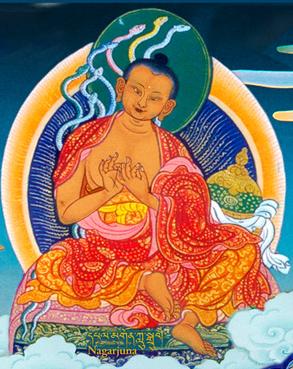
Acharya Nāgārjuna was an Indian philosopher who founded the Madhyamaka school of Mahāyāna Buddhism.
His writings are the basis for the formation of the Madhyamaka school, which was transmitted to China under the name of the Three Treatise (Sanlun) School. He is credited with developing the philosophy of the Prajnaparamita sutras, and was closely associated with the Buddhist university of Nalanda. In the Jodo Shinshu branch of Buddhism, he is considered the First Patriarch.
Little is known about the actual life of the historical Nagarjuna. The two most extensive biographies of Nagarjuna, one in Chinese and the other in Tibetan, were written many centuries after his life and incorporate material seen by some as historically unreliable. Nagarjuna was born a Brahmin, which in his time connoted religious allegiance to the Vedas, probably into an upper-caste Brahmin family and probably in the southern Andhra region of India.
Very few details on the life of Nāgārjuna are known, although many legends exist. He was born in Southern India, near the town of Nagarjunakonda in present day Nagarjuna Sagar in the Guntur district of Andhra Pradesh.According to traditional biographers and historians such as Kumarajiva, he was born into a Brahmin family, but later converted to Buddhism. This may be the reason he was one of the earliest significant Buddhist thinkers to write in classical Sanskrit rather than Pāli or Buddhist Hybrid Sanskrit.
From studying his writings, it is clear that Nāgārjuna was conversant with many of the Nikaya school philosophies and with the emerging Mahāyāna tradition. However, affiliation to a specific Nikaya school is difficult, considering much of this material is presently lost. If the most commonly accepted attribution of texts holds, then he was clearly a Māhayānist, but his philosophy holds assiduously to the non-Mahāyāna canon, and while he does make explicit references to Mahāyāna texts, he is always careful to stay within the parameters set out by the canon.
Nagarjuna may have arrived at his positions from a desire to achieve a consistent exegesis of the Buddha’s doctrine as recorded in the Canon. In the eyes of Nagarjuna the Buddha was not merely a forerunner, but the very founder of the Madhyamaka system. David Kalupahana sees Nagarjuna as a successor to Moggaliputta-Tissa in being a champion of the middle-way and a reviver of the original philosophical ideals of the Buddha.
There exist a number of influential texts attributed to Nāgārjuna, although most were probably written by later authors. The only work that all scholars agree is Nagarjuna’s is the Mūlamadhyamakakārikā (Fundamental Verses on the Middle Way), which contains the essentials of his thought in twenty-seven short chapters. According to Lindtner the works definitely written by Nagarjuna are:
* Mūlamadhyamaka-kārikā (Fundamental Verses of the Middle Way)
* Śūnyatāsaptati (Seventy Verses on Emptiness)
* Vigrahavyāvartanī (The End of Disputes)
* Vaidalyaprakaraṇa (Pulverizing the Categories)
* Vyavahārasiddhi (Proof of Convention)
* Yuktiṣāṣṭika (Sixty Verses on Reasoning)
* Catuḥstava (Hymn to the Absolute Reality)
* Ratnāvalī (Precious Garland)
* Pratītyasamutpādahṝdayakārika (Constituents of Dependent Arising)
* Sūtrasamuccaya
* Bodhicittavivaraṇa (Exposition of the Enlightened Mind)
* Suhṛllekha (To a Good Friend)
* Bodhisaṃbhāra (Requisites of Enlightenment)
Nāgārjuna’s primary contribution to Buddhist philosophy is in the use of the concept of śūnyatā, or “emptiness,” which brings together other key Buddhist doctrines, particularly anātman (no-self) and pratītyasamutpāda (dependent origination), to refute the metaphysics of Sarvastivāda and Sautrāntika (extinct non-Mahayana schools). For Nāgārjuna, as for the Buddha in the early texts, it is not merely sentient beings that are “selfless” or non-substantial; all phenomena are without any svabhāva, literally “own-being” or “self-nature”, and thus without any underlying essence. They are empty of being independently existent; thus the heterodox theories of svabhāva circulating at the time were refuted on the basis of the doctrines of early Buddhism. This is so because all things arise always dependently: not by their own power, but by depending on conditions leading to their coming into existence, as opposed to being. Nāgārjuna was also instrumental in the development of the two-truths doctrine, which claims that there are two levels of truth in Buddhist teaching, one which is directly (ultimately) true, and one which is only conventionally or instrumentally true, commonly called upāya in later Mahāyāna writings. Nāgārjuna drew on an early version of this doctrine found in the Kaccāyanagotta Sutta, which distinguishes nītārtha (clear) and neyārtha (obscure) terms.
Source: Wikipedia




